NATIVE GRASS ECOTYPES AND THEIR
REVOLUTIONARY IMPLICATIONS FOR
GENETICISTS, BIODIVERSITY, CONSERVATION, TAXONOMY, EVOLUTIONARY
SCIENCES, AND ECOLOGICAL RESTORATION.
--Implications for genetic studies
--Implications for biodiversity, conservation and taxonomy
--Implications for ecology and ecological restoration practitioners
--Implications for evolutionary sciences
--Establishing ecotype refugia: The Native Heritage Program.
--A history of ecotype and related research: 1880-1996, in chronological order.
--Photos of six native grass (Bromus carinatus) ecotypes from the San Francisco Bay Area
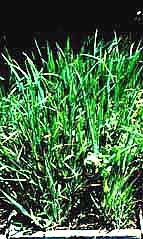
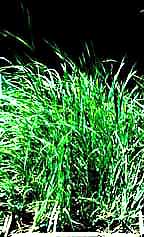
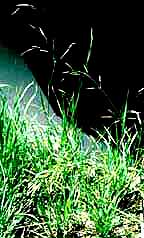
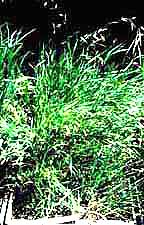
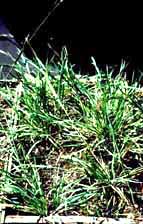

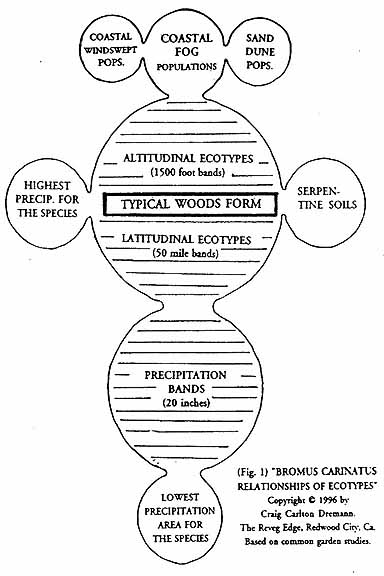
The concept of setting aside Native Heritage Preserves throughout
the United States could be developed state-by-state, with a baseline
of one for every 225 square miles. For example, you would divide
the area of Maryland (12,407 square miles) by 225, then a minimum
of 55 refugia would be needed for that state. This formula would
even work well in small states like Hawaii where there is known
to be a large amount of biodiversity: a minimum of 48 refugia
for the island chain. We need to start thinking now: "what
is the minimum we are going to preserve for the future?"
Within these preserves, or refugia, we would be banking future
genetic material, models of the community structure, and wonders
for future generations to discover. These preserved refugia, like
the relict areas in India researched by Gadgil & Vartak (1976),
may end up being the only intact examples of native ecosystems
in the future. We when we preserve 680 relict refugia for California's
future, this only represents one acre in exchange for every 10,000
we've taken for our own use.
Every seed company that sells native grass seed and every person
who plants native grass seed or plants depends on the existence
of the relict grass stands for their original genetic material.
Now is the time for the relict stands to depend on us, for their
continued survival. In exchange for the gifts they have given
us in the past, we must guarantee that their gifts will be available
for the future.
1880. Goebel, Karl. "Beitrage zur Morphologie und Physiologie der Blätter." BOT. ZEIT. 38: 763.
1887. Bonnier, Gaston. "Note sur les cultures comparées des mêmes espèces à diverses altitudes." BULL. SOC. BOT. FRANCE. 34: 467-469.
1888. Bonnier, G. "Étude expérimentale de l'influence du climat alpin sur la végétation et les fonctions des plantes." BULL. SOC. BOT. FRANCE. 35: 436-439.
1890. Bonnier, G. "Cultures expérimnetales dans les Alpes et les Pyrénées." REV. GÉN. BOT. 2: 513-546.
1890. Lesage, M. P. "Recherches expérimentales sur les modifications des feuilles chez les plantes maritimes." REVUE GÉNÉRALE BOT. V.2.
1894. Kerner, Anton J. The Natural History of Plants, their Forms, Growth, Reproduction and Distribution. London. Blackie & Son Ltd.
1895. Bonnier, G. "Recherches expérimentales sur l'adaptation des plantes au climat alpin." ANN. SCI. NATURELLES-BOTANIQUE. 7(20): 217-360.
1895. Genslow, G. The Origin of Plant Structures by Self-adaptation to the Environment. London.
1896. Kolderup-Rosenvinge, L. "Det sydligsle Grönlands vegetatioin." MEDD. OM GRÖNL. Bd. 15.
1903. Klebs, G. Willkürliche Entwicklungsänderungen bei Pflanzen. Jena, G. Fischer.
1905. Gluck, J. T. Evolution, Racial and Habitudinal. PUB. CARNEGIE INST. WASH. No. 25.
1905. Greene, Edward L. Revision of Eschscholtzia. PITTONIA 5: 205-293. This is the first detailed botanical description and key to ecotypes and their geographic ranges of any genus of plants. Greene lacked the concept and term "ecotype", which was not invented or commonly used until two decades later; so Greene organized his eoctypes into 112 "species". His work has been generally ignored and even scoffed at, because taxonomist even to this day do not want to believe that there are possibly 112 species of California poppy. But if we now recognize his "species" as ecotypes, then it makes his paper an important historic and pioneering document: valuable for conducting ecological restoration of California wildlands, today and far into the future.
1905. Jordan, David Starr. "The origin of species through isolation." SCIENCE. 22.
1906. Klebs, G. Über künstliche Metamorphosen. Abh. d. Naturf. Gesellsch. Halle. Bd. 25
1907. Clements, F. E. "Causes of alpine dwarfing." SCIENCE. 25: 287.
1907. Clements, F. E. "Origin of new life forms in nature." SCIENCE. 25: 287.
1908. Clements, F. E. "An ecological view of the species concept." AMER. NAT. 42: 253.
1913. Bateson, W. Problems of Genetics. New York and London.
1913. Goebel, Karl. Organographie der Pflanzen. Teill. 2 Aufl. Jena.
1918. Heribert-Nilsson, N. "Experimentelle Studien über Variatbilität Spaltung. Artbildung und Evolution in der Gattung Salix." LUNDS UNIVERSITETS ÄRSSKRIFT. N.F. Avd. 2 Bd. 14, No. 28.
1919-26. Clements, F. E. and H. M. Hall. "Reciprocal transplants: experimental taxonomy." CARNEGIE INST. WASH. YEARBOOKS No. 18-26.
1919. Turesson, Göte. "The cause of plagiotropy in maritime shore plants." LUNDS UNIVERSITETS ARSSKRIFT. N.F. Avd. 2 Bd. 16, No. 2.
1920. Bonnier, G. "Nouvrelles observations sur les cultures expérimentales à diverses altitudes." REV. GÉN. BOT. 32: 305.
1921. Hagedoorn, A.L. and A.C. The Relative Value of the Processes Causing Evolution. The Hague.
1922a. Turesson, Göte. "The species and variety as ecological units." HEREDITAS. 3: 100-113.
1922b. Turesson, Göte. "The genotypical response of the plant species to the habitat. HEREDITAS. 3: 211-350. [Good black and white photos of ecotypes!].
1923. Hall, Harvey M and Fredric E. Clements. "The Phylogenetic Method in Taxonomy. The North American Species of Artemisia, Chrysothamnus, and Atriplex. CARNEGIE INST. WASHINGTON, Publ. 326. 355 pp.
1923. Turesson, Göte. "The scope and import of genecology." HEREDITAS. 4: 171-176
1925-7. Clements, F.E. Ecogenesis. CARNEGIE INST. WASH. YEARBOOKS 24: 310; 25: 335; 26: 305.
1925. Turesson, Göte. "The plant species in relation to habitat and climate." Contributions to the knowledge of genecological units." HEREDITAS. 6: 147-236
1926. Hall, H. W. et al. Experimental taxonomy. CARNEGIE INST. WASH. YEARBOOK. 25: 345-346.
1926. Gregor, J. W. , and F. W. Sansome. "Experiments on the genetics of wild populations. Part 1. Grasses." J. GENETICS 17:349-364.
1927. Turesson, G. "Contributions to the genecology of glacial relics." HEREDITAS. 9:81-101
1928. Stapledon, R. G. "Cocksfoot grass (Dactylis glomerata) ecotypes in relation to the biotic factor." JOURNAL ECOLOGY. 16 (1): 71-104, pl. XII-XVII. [Excellent black and white photos!].
1929. Clements, Frederic E. "Experimental methods in adaptation and morphology." JOURNAL ECOLOGY. 17: 356-379.
1930. Gregor, J. W. "Experiments on the genetics of wild populations. I. Plantago maritima, L. JOUR. GEN. 22 (1): 15-25, pl. 1-2.
1930. Turesson, G. "The selective effect of climate upon the plant species." HEREDITAS 14: 99-152.
1931. Gregor, J. W. "Experimental delimitation of species." NEW PHYTOLOGIST. 30: 204-217.
1931. Turesson, G. "The geographic distribution of the alpine ecotype of some Eur-asiatic plants." HEREDITAS. 15: 329-346
1931. Sinskaia, E. N. "The study of species in their dynamics and interrelation with different types of vegetation." BULL. APPL. BOT., GENET and PLANT BREED. 25(2): 50-97.
1932. Brown-Blanquet, J. Plant Sociology: The Study of Plant Communities. McGraw-Hill, New York.
1936. Gregor, J. W. , V. McM. Davey, and J. M. S. Lang. "Experimental taxonomy. I. Experimental garden technique in relation to the recognition of the small taxonomic units." NEW PHYTOL. 35:323-350.
1937. Faegri, Knut. "Some fundamental problems of taxonomy and phylogenetics." BOT. REV. (Lancaster) 3: 400-423, 451-456.
1937. Clements, F. E. et al. Adaptation and Origin. CARNEGIE INST. WASH. YEARBOOK. 36: 222-224
1939. Clausen, J., D. D. Keck and W. M. Hiesey. "The concept of species based on experiment." AMER. BOT. 26:103-108.
1939. Clements, F. E. et al. Adaptation and Origin. CARNEGIE INST. WASH. YEARBOOK. 38: 134-137.
1939. Gregor, J. W. "Experimental taxonomy. IV. Population differentiation in North American and European seaplantains allied to Plantago maritima L." NEW PHYTOL. 38:293-322.
1940. Clausen, J., D. D. Keck and W. M. Hiesey. Experimental Studies on The Nature of Species. I. Effect of Varied Environments on Western North American Plants. CARNEGIE INST. OF WASH., Publ. 520, 452 pp. Illus.
1940. Hiesey, William M. "Environmental influence and transplant experiments. BOT. REV. (Lancaster) 6:181-203.
1941. Allard H. A. and M. W. Evans. "Growth and flowering of some tame and wild grasses in response to different photo-periods." JOUR. AGR. RES. 62: 193-228.
1941. Clausen, J., D. D. Keck and W. M. Hiesey. "Regional differentiation in plant species." AMER. NATUR. 75:231-250.
1941. Clausen, Robert T. "On the use of the terms 'subspecies' and 'variety'." RHODORA 43: 157-167.
1941. Hopkins, H. "Variations in the growth of sideoats grama grass at Hays, Kansas, from seed produced in various parts of the Great Plains Region." TRANS. KANS. ACAD. SCI. 44:86-95.
1942. Clausen, J., D. D. Keck, W. M. Hiesey and E. V. Martin. Experimental Taxonomy. CARNEGIE INST. WASH. YEARBOOK. 41: 126-134.
1942. Fosberg, F. Raymond. "Subspecies and variety." RHODORA 44: 153-167.
1942. Gregor, J. W. "The units of experimental taxonomy." CHRONICA BOTANICA. 7 (5): 193-196.
1943. Camp, Wendell H. and Charles L. Gilly."The structure and origin of species." BRITTONIA 4: 323-385.
1944. Gregor, J. W. "The ecotype." CAMBRIDGE BIOL. REV. 19: 20-30.
1944 Grinnell, Joseph and Alden H. Miller. Distribution of the Birds of California. Reprint, Artemisia Press, Lee Vining, California.
1944. Olmated, C. E. "Growth and development in range grasses. IV. Photoperiodic responses in twelve geographic strains of sideoats grama." BOT. GAZ. 106:46-74.
1944a. Wright, J. W. "Genotypic variation in white ash." J. FOREST. 44: 489-495.
1944b. Wright, J. W. "Ecotypic differentiation in red ash." J. FOREST. 42: 591-597.
1945. Clausen, J., D. D. Keck and W. M. Hiesey. Experimental Studies on the Nature of Species. II. Plant Evolution Through Amphiploidy and Autoploidy, with Examples from the Madiinae. CARNEGIE INST. WASH. PUB. No. 564.
1945. Lawrence, W. E. "Some ecotypic relations of Deschampsia caespitosa." AMER. J. BOT. 32:298-314.
1945. Olmated, C. E. "Growth and development in range grasses. V. Photoperiodic responses of clonal divisions of three latitudinal strains of sideoats grama." BOT. GAZ. 106: 382401.
1946. Gregor, J. W. "Ecotypic differentiation." NEW PHYTOL. 45:254-270.
1946a. Mason, H. L. "The edaphic factor in narrow endemism. I. The nature of environmental influences." MADRONO 8: 209-226.
1946b. Mason, H. L. "The edaphic factor in narrow endemism. II. The geographic occurrence of plants of highly restricted patterns of distribution." MADRONO 8:241-257.
1946. Smith, D. C., E. L. Nielsen, and H. L. Ahlgren. "Variation in ecotypes of Poa pratensis." BOT. GAZ. 108:143-166.
1946. Turrill, W. B. "The Ecotype concept: A consideration with appreciation and criticism, especially of recent trends" NEW PHYTOL. 45: 34-43.
1947. Clausen, J., D. D. Keck and W. M. Hiesey. "Heredity of geographically and ecologically isolated races." AMER. NATUR. 81:114-133.
1947. Cornelius, D. R. "The effect of source of little bluestem grass seed on growth, adaptation, and use in revegetation seedings." J. AGR. RES. 74: 133-143.
1947. Larson, E. C. "Photoperiodic responses of geographical strains of Andropogon scoparius." BOT. GAZ. 109: 132-149.
1948. Clausen, J., D. D. Keck and W. M. Hiesey. Experimental Studies on the Nature of Species. III. Environmental Responses of Climatic Races of Achillea. CARNEGIE INST. WASH. PUB. 581.
1950. Kruckeberg, A. R. An experimental inquiry into the nature of endemism on serpentine soils. Ph.D. Thesis, Univ. California Berkeley.
1950. Mason, Herbert L. "Taxonomy, systematic botany and biosystematics." MADRONO 10: 161-192.
1951. Clausen, Jens. Stages in the Evolution of Plant Species. Cornell Univ. Press, Ithaca, NY. 206 pp.
1951. Kruckeburg, A. R. "Intraspecific variability in the response of certain native plant species to serpentine soil." AMER. J. BOT. 38:408-419.
1951. Vavilov, Nikolai Ivanovich. "The origin, variation, immunity and breeding of cultivated plants. I. Phytogeographic basis of plant breeding." CHRONICA BOTANICA. 13 (1): 1-54.
1952. Bradshaw, A. D. "Populations of Agrostis tenuis resistant to lead and zinc poisoning." NATURE 169:1098.
1953. Constance, Lincoln. "The role of plant ecology in biosystematics." Ecology 34: 642-649.
1953a. Hiesey, W. M. "Comparative growth between and within , climatic races of Achillea under controlled conditions." EVOLUTION 7:297-316.
1953b. Hiesey, W. M. "Growth and development of species and hybrids of Poa under controlled temperatures." AMER. J. BOT. 40:205-221.
1954. Gregor, J. W. and P.J. Watson. "Some observations and reflections concerning the patterns of intraspecific differentiation." NEW PHYTOL. 53:291-300.
1954. Kruckeburg, A. R. "The ecology of serpentine soils." ECOLOGY 35:267-274.
1956a. McMillan, C. "Nature of the plant community. Uniform garden and light period studies of five grass taxa in Nebraska." ECOLOGY 37:330-340.
1956b. McMillan, C. "Nature of the plant community. II. Variation in flowering behavior within populations of Andropogon scoparius." AMER. J. BOT. 43:429-436.
1957. Harberd, D. J. "The within population variance in genecological trials." NEW PHYTOL. 56:269-280.
1957. Irgens-Moller, H. "Ecotypic response to temperature and photo-period in Douglasfir." FOREST SCI. 3:7983.
1957. McMillan, C. "Nature of the plant community. III. Flowering behavior within two grassland communities under reciprocal transplanting." AMER. J. BOT. 44: 144-153.
1958. Clausen, J. and W. M. Hiesey. Experimental Studies on the Nature of Species. IV. Genetic Structure of Ecological Races. CARNEGIE INST. WASH. PUB. 615
1958. Bjorkman, O., C. Florell, P. Holmgren. and P. Holmgren. "Preliminary observations on to anthocyanins and other flavonoid compounds and respiration rates in different ecotypes of Solidago virgaurea." PHYSIOL. PLANT. 11: 154-157.
1958. Clausen, J. and W. M. Hiesey. Experimental studies on the nature of species. IV. Genetic structure of ecological races." CARNEGIE INST. WASH. Publ. 615. Washington, D. C.
1958. Morley, F. H. W. "The inheritance and ecological significance of seed dormancy in subterranean clover (Trifolium subterraneum L.)." AUST. J. BIO. SCI. 11:261-274.
1958. Valentine, D. H. and Askell Love "Taxonomic and biosystematic categories." BRITTONIA 10: 153-166.
1959. Decker, J. P. "Some effects of temperature and carbon dioxide concentration on photosynthesis of Mimulus." PL. PHYSIOL. 34: 103-106.
1959. Eberhart, S. A and L. C. Newell. "Variation in domestic collections of switchgrass, Panicum virgatum L." AGRON. J. 51:613-616.
1959. Heslop-Harrision, J. "Variability and environment." EVOLUTION 13:145-147.
1959. Heywood, V. H. "The Taxonomic treatment of ecotypic variations" in Function and Taxonomic Importance, pages 87-112. The Systematics Association, Publ. No. 3. Academic Press, London, UK.
1959. Milner, H. W., W. M. Hiesey, and M. A. Nobs. Physiology of Climatic Races. CARNEGIE INST. WASH. YEAR BOOK 58: 346-350
1959. Vaartaja, O. "Evidence of photoperiodic ecotypes in trees." ECOL. MONOGR. 29: 91-111
1959a. McMillan, C. "The role of ecotypic variation in the distribution of the central grassland of North America." ECOL. MONOGR. 29:285-308.
1959b. McMillan, C. "Nature of the plant community. V. Variation within the true prairie community type. AMER. J. BOT. 46:418-424.
1960. Bjorkman, O., C. Florell, and P. Holmgren. "Studies of climatic ecotypes in higher plants. The temperature dependence of apparent photosynthesis in different populations of Solidago virgaurea." ANN. ROY. AGR. COLL. SW. 26: 1-10.
1960. Boivin, Bernard. "A classical taxonomist looks at experimental taxonomy. REV. CANADIAN BIOL. 19: 435-444.
1960. Bradshaw, A. D. "Population differentiation in Agrostis tenuis Sibth., III. Populations in varied environments." NEW PHYTOL. 59:92-103.
1960. Heslop-Harrision, J. New Concepts in Flowering Plant Taxonomy. Harvard Univ. Press, Cambridge, Mass. 134 pages.
1960. McMillan, C. "Ecotypes and community function." AMER. NAT. 96: 245-255.
1960. Milner, H. W., W. M. Hiesey, and M. A. Nobs. Physiology of Climatic Races. CARNEGIE INST. WASH. YEAR BOOK. 59: 313-318
1960. Perry, F. O. and C. W. Wang. "Genetic variation in the winter chilling requirement for date of dormancy break for Acer rubrum." ECOLOGY 41: 790-794.
1960. Wilkins, D. A. "Recognizing adaptive variants." PROC. LINN. SOC., LOND. SESSION 171:122126.
1961. Bjorkman and P. Holmgren. "Studies of climatic ecotypes of higher plants. Leaf respiration in different populations of Solidago virgaurea." ANN. ROY. AGR. COLL. SW. 27:297-304.
1961. Gregor, J. W. and P.J. Watson. "Ecotypic differentiation: observations and reflections." EVOLUTION 15:166-173.
1961. McMillan, C. "Nature of the plant community. IV. Texas grassland communities under transplanted conditions." AMER. J. BOT. 48:778-785.
1961. Milner, H. W., W. M. Hiesey, and M. A. Nobs. Physiology of Climatic Races. CARNEGIE INST. WASH. YEAR BOOK. 60: 379-380
1961. Mooney, H. A. and W. D. Billings. "Comparative physiological ecology of arctic and alpine populations of Oxyria digyna." ECOL. MONOGR. 31: 1-29.
1961. Tieszen, L. L. "Demonstration of photoperiodic ecotypes in Liriodendron and Quercus" CAN. J. BOT. 39:649-654.
1962. Bjorkman, O., P. Holmgren, and M. A. Nobs. Ecotypic Differences in Response to Light Intensity in Solidago virgaurea. CARNEGIE INST. WASH. YEAR BOOK 61:320-325.
1962. Cook, Stanton A. "Genetic system, variation, and adaptation in Eschscholzia californica." EVOLUTION 16: 278-299.
1962. Grant, S. A. and R. F. Hunter. "Ecotypic differentiation of Calluna vulgaris in relation to altitude." NEW PHYTOL. 61:44-55.
1962. Lodge, R. W. "Autecology of Cynosurus cristatus L. II. Ecotypic variation." J. ECOL. 50: 75-86.
1962. McKell, C. M., R. W. Robertson, and J. Major. "Ecotypic variation in medusahead, an introduced annual grass." ECOLOGY 43: 686-689.
1962. Milner, H. W., W. M. Hiesey, and M. A. Nobs. Physiology of Climatic Races. CARNEGIE INST. WASH. YEAR BOOK. 61: 313-317
1963. Bjorkman O. and P. Holmgren. "Adaptability of the photosynthetic apparatus to light intensity in ecotypes from exposed and shaded habitats." PHYSIOL. PLANT. 16: 889-914.
1963. Bourdeau, P. F. "Photosynthesis and respiration of Pinus strobus, L. Seedlings in relation to provenance and treatment." ECOLOGY 44: 710-716.
1963. Gregor, J. W. "Genecological (biosystematic) classification: The case for special categories." REGNUM VEGETABILE 27: 24-26.
1963. Heslop-Harrison, J. New Concepts in Flowering Plant Taxonomy. Heinemann, London. 134 pp.
1963. Kwano, S. "Cytogeography and evolution of the Deschampsia caespitosa complex." CAN. J. BOTANY 41: 719-742.
1963. Langdrige, J. "Biochemical aspects of temperature response." ANN. REV. PLANT PHYSIOL. 14:44l-460.
1963. Merxmueller, Hermann. "The incompatibility between formal taxonomic recognition of units and their biosystematic definition." REGNUM VEGETABILE 27: 57-62
1963. Milner, H. W., W. M. Hiesey, and M. A. Nobs. Physiology of Climatic Races. CARNEGIE INST. WASH. YEAR BOOK 62: 393.
1963. Mooney, H. A. "Physiological ecology of coastal, subalpine and alpine populations of Polygonum bistortoides." ECOLOGY. 44: 812-816.
1964. Heslop-Harrision, J. "Forty years of genecology." In J. B. Craggs, ed., In Advances in Ecological Research, Volume 2, pages 159-264. Academic Press, London and New York.
1964. Hiesey, William M. "The genetic-physiological structure of species complexes in relation to environment", in Genetics Today. Proc. XI Internat. Congr. Genetics. Pergamon Press, London.
1964. Jowett, D. "Population studies on lead tolerant Agrostis tenuis." EVOLUTION 18 (1):7080.
1964. McCormick, J. F. and R. B. Platt. "Ecotypic differentiation in Diamorpha cymosa." BOT. GAZ. 125: 271-279.
1964. McMillan, C. "Ecotypic differentiation within four North American prairie grasses. I. Morphological variation within transplanted community fractions." AMER. J. BOT. 51:1119-1128.
1964. McNaughton, S. J. and M. West. "Photosynthetic acclimation of plants of diverse origin." AMER. J. BOT. 51: 825-827.
1964. Mooney, H. A., R. D. Wright, and B. R. Styrain. "The gas exchange capacity of plants in relation to vegetation zonation in the White Mountains of California." AMER. MIDL. NATUR. 72:281-297.
1964. Nixon, E. S., and C. McMillan. "The role of soil in the distribution of four grass species in Texas." AMER. MID. NATUR. 71: 114-140.
1964a Milner, H. W., and W. M. Hiesey. "Photosynthesis in climatic races of Mimulus I. Effect of light intensity and temperature on rate. PLANT PHYSIOL. 39: 208-213.
1964a Milner, H. W., and W. M. Hiesey. "Photosynthesis in climatic races of Mimulus lewissi. CARNEGIE INST. WASH. YEAR BOOK 64: 425-429.
1964b Milner, H. W., and W. M. Hiesey. "Photosynthesis in climatic races of Mimulus I. Effect of light intensity and temperature on rate. PLANT PHYSIOL. 39: 746-750.
1965. Bjorkman O. Comparative Physiological Studies of Ecological Races of Solidago. CARNEGIE INST. WASH. YEAR BOOK 64: 415-420.
1965. Bjorkman, O., W. M. Hiesey and M. A. Nobs. Light utilization in ecological races of Mimulus cardinalis. CARNEGIE INST. WASH. YEAR BOOK 64: 420-424.
1965. Bradshaw, A. D. "Evolutionary significance of phenotypic plasticity in plants." ADV. GENET. 13: 115-155.
1965. Hiesey, W. M. and H. W. Milner. "Physiology of ecological race and species." ANN. REV. PLANT PHYS. 16: 203-216.
1965. Krueger, K. W. and W. K. Ferrell. "Comparative photosynthetic and respiration responses to temperature and light by Pseudotsuga menziesii var. menziesii and var. glauca." ECOLOGY 46:750-751.
1965. Mark, A. F. "Ecotypic differentiation in Otago populations of narrowleaved snow tussock, Chionochloa rigda." NEW ZEALAND J. BOT. 3:277-299.
1965. McNaughton, S. J. and A. W. Johnson. "Comparative physiological ecology of an arctic and alpine population of Thalictrum alpinum L." ECOLOGY 46: 721-727.
1965. McNaughton, S. J. "Differential enzymatic activity in ecological races of Typha latifolia L." SCIENCE 150: 1829-1830.
1965. Peakcock, J. T. and C. McMillan. "Ecotypic differentiation in Prosopis (Mesquite)." ECOLOGY 46:35-51.
1965. Tieszen, L. L. Photosynthetic Adaptations to the Light Intensity in Arctic and Alpine Populations of Deschampsia caespitosa. Unpubl. Ph.D. Dissertation, U. of Colo. 192 p.
1965a. McMillan, C. "Ecotypic differentiation within four North American prairie grasses. II. Behavioral variation within transplanted community fractions." AMER. J. BOT. 52:55-65.
1965b. McMillan, C. "Grassland community fractions from central North America under simulated climates." AMER. J. BOT. 52: 109-116
1966. Bjorkman O. and P. Holmgren. "Photosynthetic adaptation to light intensity in plants native to exposed and shaded habitats." PHYSIOL. PLANT. 19:854-859.
1966. Hiesey, W. M., O. Bjorkman and M. A. Nobs. Light saturated rates of photosynthesis in Mimulus cardinalis." CARNEGIE INST. WASH. YEAR BOOK 65:481-464.
1966. Klikoff, L. G. "Temperature dependence of the oxidative rates of mitochondria in Danthonia intermedia, Penstemon davidsonii and Sitanion hystrix." NATURE 212:529-530.
1966. Kwano, S. "Biosystematic studies of the Deschampsia caespitosa complex with special reference to the karvology of Icelandic populations." THE BOT. MAG., TOKYO 79:293-307.
1966. Marchand, L. S., A. McLean, and E. W. Tisdale. "Uniform garden studies on the Artemisia tridentata Nutt. complex in interior British Columbia." CAN. J. BOT. 44: 1623-1632.
1966. Strain, B. R. and V. C. Chase. "Effect of past and prevailing temperatures on the carbon dioxide exchange capacities of some woody desert perennials." ECOLOGY 47:1043-1045.
1966a. Bjorkman O. "Comparative studies of photosynthesis and respiration in ecological races." BRITTONIA 18:214-224.
1966a. McNaughton, S. J. "Ecotype function in the Typha community type." ECOL. MONOGR. 36:297-325.
1966b. Bjorkman O. Carboxydismutase Activity in Relation to Light Saturated Rate of Photosynthesis in Plants from Exposed and Shaded Habitats. CARNEGIE INST. WASH. YEAR BOOK 65:454-459.
1966b. McNaughton, S. J. "Thermal inactivation properties of enzymes from Typha latifolia L. ecotypes." PLANT PHYSIOL. 41: 1736-1738.
1966c. McNaughton, S. J. "Oxidase activity in ecotypic populations of Typha latifolia L." NATURE
1967. Bjorkman, O., C. Florell, P. Holmgren. and M. Bjorkman. Carboxydismutase Activity in Sun and Shade Leaves of Solidago. CARNEGIE INST. WASH. YEAR BOOK 66: 216-220.
1967. Miller, R. V. "Ecotypic variations in Andropogon scoparius and Bouteloua gracilis. Unpubl. Ph.D. dissertation. Colorado State University. 154 p.
1967. Williams, G. J. "Respiration and respiratory enzyme activity in latitudinal ecotypes of Liquidambar styraciflua L." ABSTR. BULL. ECOL. EOC. AMER. 48: 78.
1968. Klikoff, L. G. "Temperature dependence of mitochondrial oxidative rates of several plant species to serpentine soil." AMER. J. BOT. 38:408-419.
1968 a. Bjorkman O. "Carboxydismutase activity in shade adapted species of higher plants." PHYSIOL. PLANT. 21:1-10.
1968 b. Bjorkman O. "Further studies on differentiation of photo synthetic properties of sun and shade ecotypes of Solidago virgaurea." PHYSIOL. PLANT. 21:84-99.
1968. Panetsos, C. A. and H. G. Baker. "The origin of variation in 'wild' Raphanus sativus (Cruciferae) in California." GENETICA 38:243-274.
1968. Wilkins, D. A. "The scale of genecological differentiation" in V. H. Heywood, ed., Modern Methods in Plant Taxonomy, pages 227-239. Academic Press, London, UK.
1969 a. Kruckeberg, Arthur R. "The implications of ecology for plant systematics." TAXON. 18: 92-120.
1969 b. Kruckeberg, Arthur R. "Ecological aspects of the systematics of plants" in Systematic Biology, pages 161-203. Nat'l. Acad. Sci., Washington DC. Pub. No. 1692
1969. Pearcy, R. W. Physiological and varied environmental studies of ecotypes of Deschampsia caespitosa (L.) Beauv. Unpubl. Ph.D. Dissertation, U. of Colo., Ft. Collins, 184 pages.
1970. Hiesey, William M. and Malcolm A. Nobs. "Genetic and transplant studies on contrasting species and ecological races of the Achillea millefolium complex." BOT. GAZ. 131: 245-259.
1971. Hiesey, W. M. M. A. Nobs and O. Björkman. Experimental Studies on the Nature of Species. V. Biosystematics, Genetics and Physiological Ecology of the Erythranthe Section of Mimulus. CARNEGIE INST. WASH. PUB. 615.
1971. Langlet, Olof. "Two hundred years [of] genecology." TAXON 20: 653-722.
1973. Heywood, V. H. "Ecological data in practical taxonomy" in Taxonomy and Ecology, pages 329-347. The Systematics Association, Special Vol. No. 5, Academic Press, London, UK.
1973. Snaydon, R. W. 1973. "Ecological factors, genetic variation and speciation in plants" in Taxonomy and Ecology, pages 1-29. The Systematics Association, Special Vol. No. 5. Academic Press, London.
1974. Raven, Peter H. "Plant systematics, 1947-1972." ANN. MISSOURI BOT. GARDEN 61: 166-178.
1976a. Antonovics, Janis. "The input from population genetics: 'The new ecological genetics'." SYST. BOT. 1:233-245.
1976b. Antonovics, Janis. "The nature of limits to natural selection." ANN. MISSOURI BOT. GARD. 63:224-247.
1976 Gadgil, Madhau and V. D. Vartak. "The Sacred Groves of Western Ghats in India." ECONOMIC BOTANY 30 (2): 152-160.
1976. Lefébvre, C. and Vernet, P. "Microevolutionary processes on contaminated deposits in J. Shaw, ed., Heavy Metal Tolerance in Plants: Evolutionary Aspects, pages 285-300. CRC Press, Boca Raton, Florida.
1977. Quinn, J. A. and J. C. Colosi. "Separating genotype from environment in germination ecology studies." AMER. MIDL. NAT. 97:484-489.
1978. Valentine, D. H. "Ecological criteria in plant taxonomy" in H. E. Street, ed., Essays in Plant Taxonomy. Academic Press, London, UK.
1981. Grant, Verne. Plant Speciation, 2nd ed. Columbia Univ. Press, New York. 563 pp.
1981. Hume, L., and P. B. Cavers. "A methodological problem in genecology. Seeds versus clones as source material for uniform gardens." CANADIAN JOUR. BOT. 59:763-768.
1982. Antonovics, J. and R. B. Primack. "Experimental ecology and genetics in Plantago. VI. The demography of seedling transplants of P. lanceolata. JOUR. ECOL. 70:55-75.
1982. Hiesey, W. M. and M. A. Nobs. Experimental Studies on the Nature of Species. VI. Interspecies Hybrid Derivatives between Facultatively Apomictic Species of Bluegrass and their Responses to Contrasting Environments. CARNEGIE INST. WASH. PUB. 636.
1983. Hagen, Joel B. "The development of experimental methods in plant taxonomy, 1920-1950." TAXON 32:406-416.
1983. Lee, W. G., A. F. Mark, and J. B. Wilson. "Ecotypic differentiation in the ultramafic flora of the South Island, New Zealand." NEW ZEALAND JOUR. BOT. 21: 141-156.
1983. Wanntorp, H.-E. "Historical constraints in adaptation theory: Traits and non-traits." OIKOS 41: 157-160.
1984. Briggs, D. and S. M. Walters. Plant Variation and Evolution. 2nd ed. Cambridge Univ. Press, Cambridge, UK. 412 pp.
1984. Hagan, Joel B. "Experimentalists and naturalists in twentieth-century botany: Experimental taxonomy, 1920-1950, JOUR. HIST. BIOL. 17:249-270.
1984. Venable, D. L. "Using intraspecific variation to study the ecological significance and evolution of plant life-histories" in R. Dirzo & J. Sarukhan, eds., Perspectives on Plant Population Ecology, pages 166-187. Sunderland, Mass.
1985. Via, S. and R. Lande. "Genotype-environment interaction and the evolution of phenotypic plasticity." EVOLUTION. 39:505-522
1987. Mayr, Ernst. "The onotological status of species: Scientific progress and philosophical terminology." BIOL. AND PHILOS. 2:145-166.
1987. Mazer, S. J. "The quantitative genetics of life history and fitness components in Raphanus raphanistrum L. (Brassicaceae): Ecological and evolutionary consequences of seed-weight variation." AMERICAN NAT. 130:891-914.
1988. Russell, G.E.G. at al. "Variations in important pasture grasses: I. Morphological and geographic variation." J. GRASSL. SOC. SOUTH AFR. 5 (1): 15-21
1990. Molder, F. "Ecotype analysis of some wild flower species, in relation to sowing grasses and wild flowers for non-intensive management." ZEITSCHRIFT FUER VEGETATIONSTECHNIK. 13 (2): 68-74
1990. Andersson, S. "The relationship between seed dormancy, seed size and weediness in Crepis tectorum (Asteraceae)." OECOLOGIA (Berl.) 83: 277-280.
1991. Andersson, S. "Geographic variation and genetic analysis of leaf shape in Crepis tectorum (Asteraceae)." PLANT SYST. EVOL. 178: 247-258.
1991. Antonovics, J. and P.H. van Tienderen. "Ontoecogenophylo-constraints? TRENDS ECOL. EVOL. 6:166-167.
1991. Schwaegerle, K. E. and D. A. Levin. "Quantitative genetics of fitness traits in wild populations of Phlox." EVOLUTION 45:169-177.
1991. Van Tienderen, P. H. and J. Van der Toorn. "Genetic differentiation between populations of Plantago lanceolata. II. Phenotypic selection in a transplant experiment in three contrasting habitats." JOURN. ECOL. 79:43-59.
1992. Theunissen, J. D. "An ecosystematic investigation of Themeda triandra (Poaceae: Andropogoneae) in the semi-arid grasslands of Southern Africa. JOURNAL OF ARID ENVIRONMENTS. 23 (1): 35-44.
1992. Theunissen, J. D., G. F. Smith and O. J. H. Bosch. "An ecosystematic investigation of Eragrostis racemosa (Poaceae: Eragrostideae) in the semi-arid grasslands of Southern Africa. JOURNAL OF ARID ENVIRONMENTS. 22: 137-145
1992. Meyer, S. and S. B. Monsen. "Genetic considerations in propagating native shrubs, forbs, and grasses from seed." In: Proceedings Western Forest Nursery Assoc. Meeting, Fallen Leaf Lake, Calif., Sept. 14-18, 1992, USDA, Forest Service General Technical Report RM-221, Rocky Mtn. Forest Exp. Sta., Ft. Collins, Colorado.
1993. Dremann, Craig and Sue Dremann. "In search of native grass ecotypes in the San Francisco Bay Area. Part one: Let's find the edges and extent of the ecotype puzzle; setting up the study." GRASSLANDS 3 (3): 1-4.
1993. Stebbins, G. Ledyard. "Concept of species and genera," In: Flora of N. America Editorial Committee, Flora of North America, North of Mexico. Introduction Vol. 1: 229-246.
1994. Dremann, Craig and Sue Dremann. "In search of native grass ecotypes in the San Francisco Bay area. Part two: Environmental influences that create ecotypes and some morphological measurements." GRASSLANDS 4 (1): 3-6.
1995. Dremann, C (ed.). Craig's Juicy Native Grass Gossip and Research. No. 1. Via the INTERNET @ http://www.ecoseeds.com/juicy.gossip.one.html
1995. Dremann, Craig C. "Bromus carinatus & Elymus glaucus storage, longevity, genetic changes and ecotypical variations." GRASSLANDS 5(3): 2-5.
1995. Kruckeberg, Arthur, Richard B. Walker and Alan E. Leviton, Eds. GENECOLOGY AND ECOGEOGRAPHIC RACES. Papers in the Biological Sciences Presented at the 73rd Annual Meeting of the Pacific Division AAAS on the Occasion of the 100th Anniversary of the Birth of Göte Turesson. Pacific Division, Amer. Assoc. for the Advancement of Science, Calif. Acad. of Sciences, San Francisco, CA. 285 pp. [A "MUST-HAVE" ITEM!] Only $28.95, hardcover on acid-free paper!
1996. Knapp, E and K. Rice. "Genetic structure and gene flow in Elymus glaucus (Blue Wild Rye): Implications for native grassland restoration." RESTORATION ECOLOGY. 4 (1): 1-10
1996. Dremann, C (ed.). Craig's Juicy Native Grass Gossip and Research. No. 2. Via the INTERNET @ http://www.ecoseeds.com/juicy.gossip.two.html